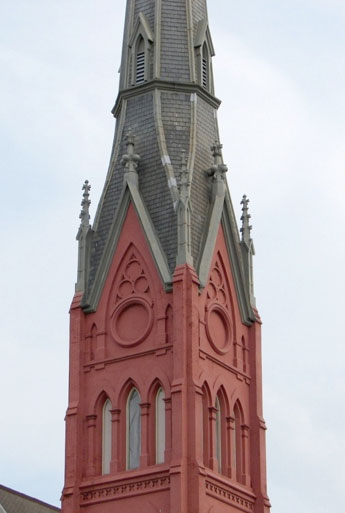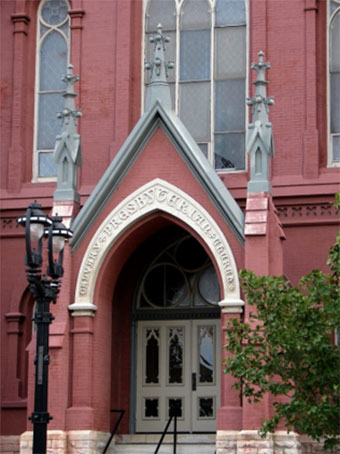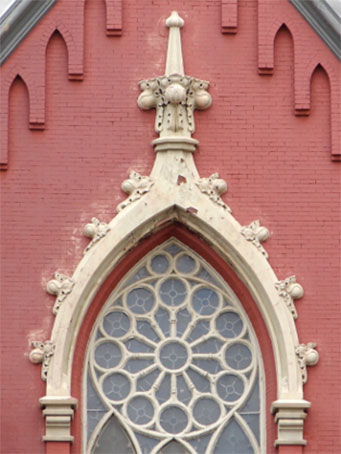27. Calvary Presbyterian, 1870
935 West Wisconsin Avenue
Architects: Koch and Hess
Prior to the establishment of Calvary Presbyterian in 1869, there were just two Presbyterian churches in the city, both located on the east side of the Milwaukee River. Members of these two churches who lived in the rapidly expanding neighborhoods on the West Side wanted a church closer to home, and formed Calvary Presbyterian for this purpose. The founders of this new church set out almost immediately to build a new house of worship, selecting a site on Grand Avenue (now Wisconsin Avenue) just a block west of the recently completed St. James Episcopal Church. After acquiring the property, they selected the Milwaukee architectural firm of Koch and Hess to design the building.
Henry Koch (1841-1910) was born near the German city of Hanover. His family immigrated to the United States in 1842 and settled in Milwaukee. As a young man, Koch worked in the office of George Mygatt, one of the city’s first architects. After serving as a topographical engineer for the Union Army during the Civil War, Koch returned to Milwaukee and to Mygatt’s office, becoming a partner in the firm of Mygatt and Koch in 1866.
In 1870, Koch formed a new partnership with the architect Julius Hess (1841-1899). A native of Switzerland, Hess had worked in the office of Edward Townsend Mix prior to the formation of Koch and Hess. The new church for Calvary Presbyterian was one of the firm’s first commissions. Koch and Hess established an office in Detroit in addition to the one in Milwaukee, but the partnership lasted only a few years. Hess assumed control of the Detroit office while Koch stayed in Milwaukee, working under the firm name of H.C. Koch and Company. Koch went on to become one of Milwaukee’s most distinguished architects, designing the present City Hall, several churches, and numerous other important buildings. Schools and government buildings made up a large portion of the firms’ practice, including designs for at least seven county courthouses in Wisconsin and several others in Iowa, Kansas, and North Dakota.
The cornerstone of Calvary Presbyterian was laid on May 10, 1871, although the stone is inscribed “1870.” The stone was probably inscribed with the expectation that it would be set in place in late 1870, but construction delays or an early winter may have caused postponement of the cornerstone laying until the following spring. Construction continued for the remainder of 1871 and into the following year, with dedication of the completed church in March of 1872.
The exterior walls of the church are Cream City brick on a base of quarry-faced stone. The yellow brick was painted red in 1887, along with the stone trim used for buttress caps, pilaster caps, and stringcourses. The church has sported a deep red color ever since.
At approximately 200 feet in height, the northwest tower and steeple overtook the tower and steeple of Olivet Congregational to briefly hold the record as the tallest steeple in Milwaukee. Two later churches, Trinity Lutheran of 1878 and St. John’s Lutheran of 1889, have steeples of comparable height. All of these were surpassed in 1892 by the approximately 230-foot steeple of St. Michael’s Catholic, followed by the 250-foot steeple of the Catholic Church of the Gesu in 1893.
Sources:
“A Beautiful Temple,” Milwaukee Sentinel, December 19, 1887, page 4, column 2.
“Brevities,” Milwaukee Sentinel, May 11, 1871, page 4, column 2.
Ells, Elizabeth H. The Days of Our Years: Calvary Presbyterian Church, 1869-1939. Schneider Printing Co., 1939.
“Its Doors Open,” Milwaukee Sentinel, December 19, 1887, page 5, column 1.
O’Brien, William P. “Milwaukee Architect: Henry C. Koch.” M.A. Thesis, University of Wisconsin – Milwaukee, 1989.



